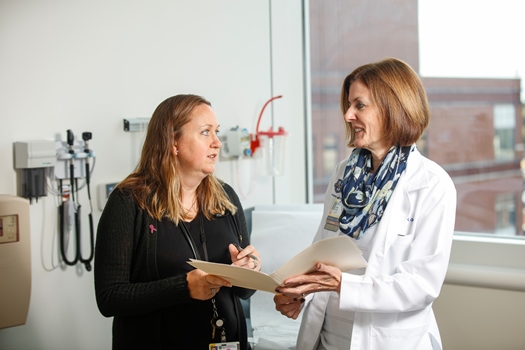Treatment
 Therapy for multiple myeloma is based on the specific type of myeloma, as well as other factors such as the patient’s age, other medical conditions, and prognosis. Myeloma cannot be cured, but treatment can reduce symptoms, slow the progression of the disease and provide prolonged remissions.
Therapy for multiple myeloma is based on the specific type of myeloma, as well as other factors such as the patient’s age, other medical conditions, and prognosis. Myeloma cannot be cured, but treatment can reduce symptoms, slow the progression of the disease and provide prolonged remissions.
A general treatment plan for myeloma may consist of three phases of treatment:
- Induction therapy for rapid control of cancer and to help relieve symptoms.
- Consolidation therapy to further eradicate cancer with more systemic medicine or with high-dose chemotherapy and a stem cell transplant.
- Maintenance therapy, which is ongoing treatment to maintain remission and keep the cancer from coming back.
There are many different types of medicines used to treat multiple myeloma, and they are often given in combination. The most common drugs used to treat myeloma include:
Proteosome inhibitors: Bortezomib (Velcade), carfilzomib (Kyprolis) and ixazomib (Ninlaro). These drugs work by preventing proteasomes from breaking down proteins that are important for controlling cell division. Bortezomib and carfilzomib are given intravenously, whereas ixazomib is a pill. The most common side effects are low blood counts, peripheral neuropathy, and reactivation of herpes zoster (shingles).
Immunomodulatory drugs: Lenalidomide (Revlimid), thalidomide (Thalomid), pomalidomide (Pomalyst). These drugs are known to work in multiple myeloma, but their mechanism of action is not entirely clear. Thalidomide causes severe birth defects when taken in pregnancy, so all of these drugs require a special program for oversight and administration. These drugs are taken as pills. They increase the risk of blood clots and are usually given along with an aspirin or blood thinner.
Corticosteroids: Dexamethasone, prednisone. Steroids can have antitumor effects in multiple myeloma and can be used alone or in combination with other medications. They can also be used to minimize nausea and vomiting from traditional chemotherapy. These drugs are given as pills, and their major side effects include agitation, insomnia, fluid retention, and elevated blood glucose.
Monoclonal antibodies: Daratumumab (Darzalex), elotuzumab (Empliciti). Daratumumab specifically targets myeloma cells which express the CD38 protein. Elotuzumab specifically targets myeloma cells which express the SLAMF7 protein. Both of the drugs help the immune system fight off myeloma cancer cells. These drugs are given intravenously, and the major side effects include infusion reactions.
Traditional chemotherapy: Melphalan, vincristine, cyclophosphamide, etoposide, doxorubicin, bendamustine. Combinations of these drugs can be more effective than a single drug. Often, your doctor will prescribe these in combination with corticosteroids and/or immunomodulating agents. The side effects of traditional chemotherapy drugs are many, and include fatigue, low blood counts, hair loss, infection risk.
Histone deacetylase (HDAC) inhibitors: Panobinostat (Farydak). This drug works by affecting which genes are turned on or off inside the cell, eventually blocking enzymes needed for cell division. This drug is given as a pill, and side effects include fatigue, electrolyte disturbance, low blood counts.
Interferon: This is a hormone-like substance that can slow the growth of myeloma cells. This medicine is given subcutaneously, and major side effects include fever, flu-like illness, and fatigue.
Radiation
Radiation therapy uses energy from radiation beams to target tumors and eradicate cancer cells. It is the main treatment for solitary plasmacytomas, and it can be used to palliate symptoms for patients whose bone pain does not respond to chemotherapy.
Stem cell transplant
Stem cell transplants are commonly used to treat multiple myeloma. Before the transplant, high-dose chemotherapy is given to kill the cells in the bone marrow. Those cells are replaced through the transplant with healthy blood-forming cells. Those new, healthy stem cells can come from either the patient (autologous transplant) or from a donor (allogeneic transplant).
Wilmot’s Blood and Marrow Transplant Program, which is the only such unit in the Finger Lakes region, has been recognized for its high level of care and detailed quality management process.
Surgery
Surgery is sometimes used to remove single plasma cell tumors called plasmacytomas. Surgery may also be used to treat, or help prevent, bone fractures caused by the myeloma.
Supportive care
These treatments address symptoms caused by multiple myeloma or caused by the medicines used to treat multiple myeloma. They can include:
- Plasmapheresis, which removes excess myeloma protein from the blood and minimizes symptoms and organ damage
- Bisphosphonate therapy, which slows bone loss and can ease bone pain.
- Blood transfusions and medications to address low blood cell counts
- Antivirals and antibiotics to prevent infections
- IVIG to help prevent infection
- Aspirin or other blood thinners to prevent blood clots
Other specialty care
Because multiple myeloma can involve many parts of the body, other specialty physicians are often included in the treatment team and can include:
- Nephrologists (kidney doctors)
- Orthopedic oncology (bone doctors)
- Pain specialists
- Palliative care specialists
- Bone marrow transplant specialists